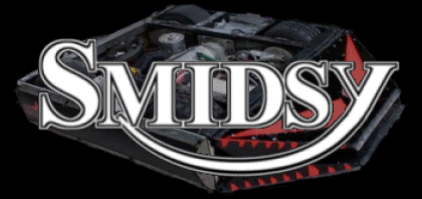A preview of the 2001 Robot Wars season
When we had finished filming in 2000, SMIDSY was virtually undamaged, we could have recharged the batteries and fought again (if we hadn't lost). For 2001 we didn't need to do anything more than replace the fake leather covering and fill in another application form. Except that we wanted to do even better, and the weight limit had gone up to 100kg and it would have been silly to enter an 80kg robot, so we had the option of entering a completly different robot.
Looking over our performance last year a few things were obvious candidates for change:
- We needed a better weapon
- The jaws weren't powerful enough or fast enough to lift anyone
- We were able to push some other robots around but Panic Attack was stronger than us
- We wanted to make it easier to steer - driving around the barrels three times before knocking them over was embarrassing!
We considered building a huge walker (because of the higher weight limit) with a big spinning disk around the outside, and an axe on a turret. It would be slow but the other robots would have to approach the disk, and we could swivel the axe to meet them. However we thought it wouldn't be very interesting to watch.
We reconsidered the design and decided that 4 wheels still gave better traction than 2 and were less prone to getting stuck on things. We still thought that an invertable design was better than a self-righter because you can start driving much sooner after you've been flipped (and we hate the term 'shrimech').
We tried to think of a way to prevent spikes getting stuck in our wheel arches (which is how Panic Attack beat us) but decided it wasn't possible and opted for a better weapon instead. The best defence is a good offence, and all that.
Weapons
We didn't want to lose the jaws, as they are a bit of a trade mark and stop us looking like yet another wheeled box but we had to get them working properly - in 2000 they couldn't lift enough weight and were still too slow. They also warped slightly from repeated ramming. Everyone said we needed a better weapon, and we eventually lost because Panic Attack was too tough to be smashed apart by ramming (and he wouldn't stand still long enough for us to get a good run up, most unsporting ;-).
We looked at the different weapons that are allowed (all the really good ones like anti-tank rockets and thermic lances are banned). Basically they fall into 4 catagories, ramming, flippers, axes (including spikes that fire in a straight line) and saws (including Hypnodisk).
- We had tried ramming, it works but needs good driving and an almost stationary opponent
- We thought another flipper would be dull, there are loads already and almost everyone can now self-right
- Axes are too difficult to aim, it's difficult to make a good one and even the good ones do little damage
That left us with saws. Dead Metal's is very impressive but less powerful versions just jam. Even Dead Metal's saw needs quite a long time to do work, and he needs to catch and hold his prey first. Hypnodisk was by far the most destructive robot for the last two years. There were a number of other spinning disks that didn't do as well (Banshee and Warpig). They did as much damage to themselves as to their opponent, we took this to mean that this kind of weapon needs careful thought and proper engineering but has the most potential.
Having decided to use a spinning disk, we had to work out where to put it. It could go right around the robot, doubling up as armour, but the bearings would be really difficult for an invertible robot and we'd lose the jaws. We could do what Hypnodisk does and have really small wheels with the disk on top, but that's not invertable at all. We decided to have a small disk, between the rear wheels. To make up for the lack of size we can make it thicker and run it faster. Fortunately, because our design has the disk in the middle, we can support both ends of the disk axle. This means it's held firmly enough to be spun very fast indeed. We couldn't make a disk as thick as we wanted so we had two disks made and mounted them with a slight gap. This protects the drive belt but is mainly because it looks good. We anticipate a number of robots will have had disks added since last year and we wanted to be a bit different. To make room for the disk we made the robot slightly wider and moved some of the electronics from the back to the front.
Better Driving
We also wanted to improve the driving characteristics. Most people don't realise that a robot is really hard to drive - they just think that most of the roboteers are bad drivers. In fact a robot is much harder to drive than a radio controlled car, especially in the heat of battle. The skid steering means that attempting to turn while driving tends to result in a spin. When you're spinning on the spot it takes a lot of power to start a robot spinning and once it starts spinning it doesn't stop straight away but carries on past the heading you were aiming for. Even just pushing the stick forward when the robot is stationary doesn't always do what you think! Often one side will power up slightly faster than the other, or one side will slip and the robot will turn slightly before it starts moving. One of my lego test robots would always do a 90 degree turn (in a random direction) before starting, it can be that bad. We wanted more pushing power and better control over our spin rate.
I really liked the steering mechanism Killahertz uses, it very cleverly combines car type steering (which is good for high speeds) with skid steering for low speeds. Unfortunately it's not 4 wheel drive and pushing power is even more important than control. We considered using hydraulic transmission to make a 4 wheel drive version. Hydraulic transmission would be really nice for other reasons too, it means you can use a petrol engine without worrying about stalling or reversing and you can have automatic gears, giving you more pushing power and a higher top speed. Maybe we'll do that next year, but we didn't have time this year.
What we did instead was to fit bigger speed controllers. The old NCC70s, although recommended by both 4QD and the motor supplier (Ellis) don't give as much power as the motors will draw when stalled. The new ones will do, so we should be able to push twice as hard; they'll also burn out our motors if we're not careful. The new robot is slightly wider, this should make it easier to start spinning as well as making the resultant spin a bit slower.
The Jaws
In 1999 the jaws were fairly powerful and reasonably fast but the mechanism kept breaking and took hours to strip down. It also got in the way of everything and weighed far too much.
In 2000 we changed it so it didn't break or get in the way, but it wasn't nearly powerful enough. We changed the gearing so it was more powerful but it was then really slow - we couldn't keep another robot on the jaw long enough to lift it! (and it was still too heavy).
This year we've made our own rack and pinion system, it's much more efficent so it's faster and more powerful. It's also smaller, lighter and doesn't get in the way of the other bits. We've also remade the jaws to be a bit stronger and stiffer and fitted a tool steel blade that's sharp enough to shave with :-)
We'll just have to wait and see if we've made the right decisions.

